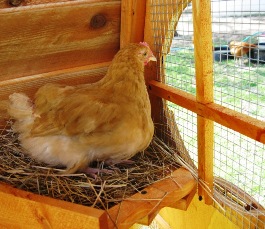QUESTION: How do I handle a hypothermic or frostbitten chicken?
by Pat on 11/14/14
ANSWER: The rare problems we have ever encountered during very cold winters are:
a. very minor frostbite on toes and/or combs
b. deeply chilled young chickens
The conditions were not ideal in each of these situations. The frostbite occurred with birds which had evaded the coop and had spent the night outdoors on a very cold, windy night. Two roosters lost some comb tips, which never seemed to bother them much. One hen lost a toe. That didn't slow her down at all.
The chilled youngsters had gotten wet, and then the temperature had dropped. We had not noticed them, and in the morning, some had died. They had been confined for a few days in a coop with inadequate ventilation, accumulating a lot of condensation.
The survivors were almost lifeless, weak and unable to move. They were revived by gradual and gentle warmth, towel drying and sugar water to stimulate their metabolism. We initially used a hair dryer, set on low, and moved around constantly. This helped fluff their feathers and dry them out. We then moved them under an incandescent bulb in a brooder to finish the process. The sugar water was given by dropper, as they initially had difficulty drinking. In a couple of hours, they were up and demanding food!
Reviving birds which have gone down is often a race to do several things at once. It helps if there are two people...one to hold the bird and use towels, etc., and one to hold a hair dryer or other gentle warming device, and to get sugar water ready to administer. Keep the hair dryer on the low setting, and far enough away to prevent burning. I just keep it moving, and constantly feel the feathering to be sure it isn't getting too hot.
Be careful not to drown the weak bird while trying to get sugar water into her. I watch for swallowing, and immediately rotate her after each dropperful, so that the excess drains out, while blotting with the towel. If she cannot swallow at all, the chances of saving her are not too good. Just keep up the warming, and massage her while using the towel to blot any remaining moisture from her feathers. I don't give up unless she goes completely still and lifeless for several minutes. The neck will no longer support her head at that point, and then I stop trying to resuscitate.

